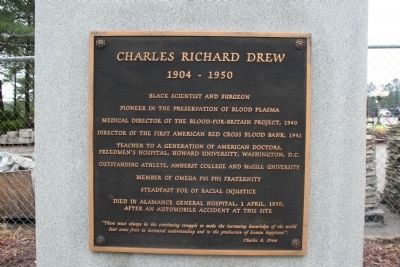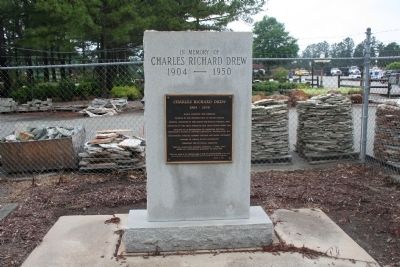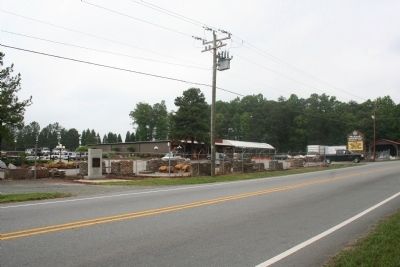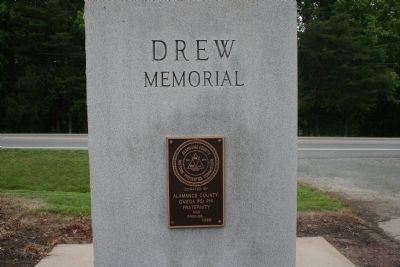Burlington in Alamance County, North Carolina — The American South (South Atlantic)
Charles Richard Drew
1904 - 1950
1904 - 1950
Black scientist and surgeon
Pioneer in the preservation of blood plasma
Medical director of the Blood-for-Britain Project, 1940
Director of the first American Red Cross Blood Bank, 1941
Teacher to a generation of American doctors, Freedmen's Hospital, Howard University, Washington, D.C.
Outstanding athlete, Amherst College and McGill University
Member of Omega Psi Phi Fraternity
Steadfast foe of racial injustice
Died in Alamance General Hospital 1 April, 1950, after an automobile accident at this site
"There must always be the continuing struggle to make the increasing knowledge of the world bear some fruit in increased understanding and in the production of human happiness". Charles R. Drew
Erected 1986 by Alamance County, Omega Psi Phi Fraternity and Friends.
Topics and series. This historical marker is listed in these topic lists: African Americans • Charity & Public Work • Civil Rights • Education • Fraternal or Sororal Organizations • Roads & Vehicles • Science & Medicine. In addition, it is included in the Historically Black Colleges and Universities series list. A significant historical date for this entry is April 1, 1950.
Location. 36° 7.726′ N, 79° 20.775′ W. Marker is in Burlington, North Carolina, in Alamance County. Marker is on NC Highway 49, on the left when traveling north. Marker is north of the town of Haw River, on the left. Located in front of the fence at Mebane Shrubbery. Touch for map. Marker is at or near this postal address: 1750 N NC Highway 49, Burlington NC 27217, United States of America. Touch for directions.
Other nearby markers. At least 8 other markers are within 5 miles of this marker, measured as the crow flies. Nathaniel Polk DeShong (approx. 2.9 miles away); Thomas M. Holt (approx. 3.2 miles away); McCray Primitive Baptist Church (approx. 3.9 miles away); The McCray School (approx. 4 miles away); a different marker also named McCray School (approx. 4 miles away); a different marker also named The McCray School (approx. 4 miles away); Henry Jerome Stockard (approx. 4.1 miles away); Bingham School (approx. 4.1 miles away). Touch for a list and map of all markers in Burlington.
Additional keywords. Medicine, African-Americans,
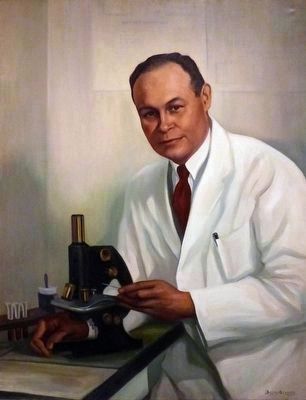
Photographed By Allen C. Browne, November 29, 2015
5. Charles Richard Drew
This 1953 portrait of Charles R. Drew by Betsy Graves Reyneau hangs in the National Portrait Gallery in Washington, DC.
“In 1940 with German bombers dropping their deadly cargoes daily on British cities, England stood in desperate need of blood supplies for its thousands of wounded civilians. To fill this shortage, the British turned to the African American physician Charles Drew, America's recognized pioneer in the preservation and storage of blood. Drew expeditiously organized the Blood Transfusion Association, and the crisis in war-torn England's hospitals was met. A year later, Drew became the medical director of the American Red Cross's blood-donor project, and it was largely because of his expertise that this enterprise saved many American lives during the war. Yet when the Red Cross ordered that all non-Caucasian blood be stored separately, Drew resigned, stating that there were no scientific or medical reasons for classifying blood by race. Today Drew is universally deemed the ‘Father of the Blood Bank.’” — National Portrait Gallery
“In 1940 with German bombers dropping their deadly cargoes daily on British cities, England stood in desperate need of blood supplies for its thousands of wounded civilians. To fill this shortage, the British turned to the African American physician Charles Drew, America's recognized pioneer in the preservation and storage of blood. Drew expeditiously organized the Blood Transfusion Association, and the crisis in war-torn England's hospitals was met. A year later, Drew became the medical director of the American Red Cross's blood-donor project, and it was largely because of his expertise that this enterprise saved many American lives during the war. Yet when the Red Cross ordered that all non-Caucasian blood be stored separately, Drew resigned, stating that there were no scientific or medical reasons for classifying blood by race. Today Drew is universally deemed the ‘Father of the Blood Bank.’” — National Portrait Gallery
Credits. This page was last revised on January 20, 2020. It was originally submitted on May 25, 2010, by Patrick G. Jordan of Graham, North Carolina. This page has been viewed 2,866 times since then and 109 times this year. Photos: 1, 2, 3, 4. submitted on May 25, 2010, by Patrick G. Jordan of Graham, North Carolina. 5. submitted on November 30, 2015, by Allen C. Browne of Silver Spring, Maryland. • Bill Pfingsten was the editor who published this page.
